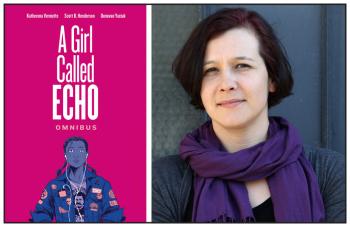Image Caption
Summary
Local Journalism Initiative Reporter
Windspeaker.com
Every superhero has an origin story and Métis teenager Echo Desjardin’s story is chronicled in the four-part graphic novel series titled A Girl Called Echo Omnibus.
“In a lot of ways, I look at Echo’s whole story as her origin story. In her last frame she has this cape, the Métis infinity flag…This is how you become solid and proud of who you are and who you come from. Learning all of these things makes Echo proud and capable and that makes her a superhero,” said Red River Métis author Katherena Vermette.
The term “superhero” may not have made it into Vermette’s lexicon had her partner, and the novel’s illustrator Scott B. Henderson, not been “comic book and superhero connoisseurs.”
She later found out from them that “Echo” is the name of a minor character in the Marvel Comics universe.
Vermette says she chose that name for her character because as a “time traveller…she really is the echo of her ancestors. She is the beat that goes on and on and on.”
The name “Omnibus” pulls together four separate graphic novels that see Echo travel through time to become part of Métis history. Her journey begins in “Pemmican Wars”, continues in “Red River Resistance”, then “Northwest Resistance” and concludes in “Road Allowance Era”.
Vermette says when she wrote the first novel in 2017 her intention had been to make it a four-part series, partly because she “liked the number four.”
And although the first three novels capture the conflicts that “were so important in shaping Métis national identity,” she knew she didn’t want Echo’s story to end in the Northwest Resistance.
“So often our (Métis) history ends with 1885. I wanted to do more,” she said. “I didn’t know I was going to concentrate on the road allowance era until further along in the process.”
While Vermette says she was “very lucky to have grown up with these stories,” many Métis children have not. She thought by approaching Echo’s adventures through graphic narrative, the history would be more accessible to both young readers and reluctant readers.
As much as Vermette already knew of Métis history, she also knew she needed to do research to fill in the details. She turned to both general Canadian sources and Métis scholarly work. It took her about a year to research each book and she learned plenty along the way.
“I did find a lot of times you have to go through…these sources that are old and out of date and sometimes blatantly racist and sometimes a little subtly racist, but you go through all of that to get those facts,” she said.
But then in the last 10 to 20 years, Métis scholarship changed the flavour of her research.
“It feels like such a breath of fresh air to be reading people who think more along the lines you think. It was a world of difference but I did feel the need to balance those two things out,” she said.
Those facts are carefully woven into Echo’s adventures often times through more graphics than words.
“I was amazed at how much story could get in there as opposed to a prose text or poetry text where you have to do so much of the explaining via words, and I didn’t have to do any of that in the graphic novel. It was really mind blowing to me to learn that,” said Vermette, who won the Governor General's Literary Award for Poetry in 2013.
Colour artist Donovan Yaciuk also played an important role in telling the story, as Echo’s historical adventures are depicted in vivid colour while her daily life is shown mostly in muted colour.
Vermette also credits her editor Annalee Greenberg for streamlining the process and enabling Vermette to establish Echo’s character.
“She’s an introverted character. She’s a shy girl. Her world is shown and that’s why a graphic novel was the perfect place for her because she wasn’t a talkative person. She wasn’t talking her way through,” said Vermette.
She adds that Echo’s look is “a homage” to the special young women in her life and “just all the other incredibly powerful little introverted young people who want to hang out behind their headphones and not talk to anybody.”
In the end, though, Echo is transformed into a confident girl, who draws support and strength from her mother and the long history of her people. She learns that even with all the hardship the Métis have suffered, they “just keep surviving,” said Vermette.
It’s this kinship or “kinscapes” that prompted Dr. Brenda Macdougall, university research chair in Métis family and community traditions, director of the Institute of Indigenous Research and Studies at the University of Ottawa, to use the Echo graphic novels series for her course on Métis history and geography.
Macdougall defines kinscapes as a “series of intertwined relational constellations of being and belonging.”
In an essay at the end of Echo Omnibus, Macdougall writes, “The power of the series, however, is the linking of the past and present as Echo struggles to understand herself and her disconnection from her mother by learning about her ancestors, her history and her homeland.”
Vermette admits that having her fictional work used in a university class as history is “daunting… History itself is really hard because there's certain factual things but so much is left for interpretation and imagination.”
A Girl Called Echo Omnibus is published by Highwater Press and is now available at https://www.portageandmainpress.com/Books/A/A-Girl-Called-Echo-Omnibus.
Local Journalism Initiative Reporters are supported by a financial contribution made by the Government of Canada.

